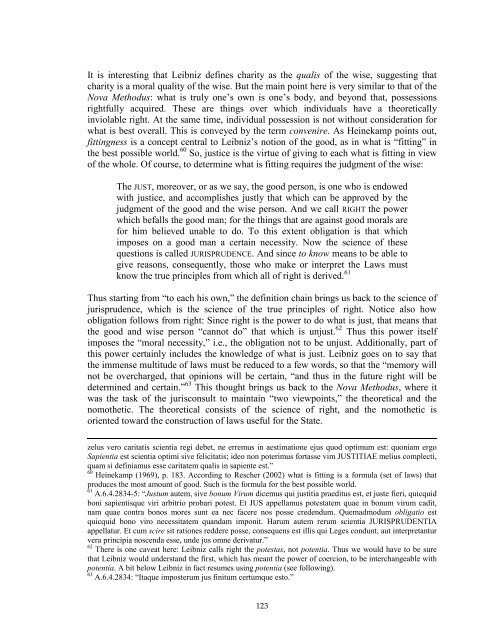Stony Brook University
Stony Brook University
Stony Brook University
You also want an ePaper? Increase the reach of your titles
YUMPU automatically turns print PDFs into web optimized ePapers that Google loves.
It is interesting that Leibniz defines charity as the qualis of the wise, suggesting that<br />
charity is a moral quality of the wise. But the main point here is very similar to that of the<br />
Nova Methodus: what is truly one’s own is one’s body, and beyond that, possessions<br />
rightfully acquired. These are things over which individuals have a theoretically<br />
inviolable right. At the same time, individual possession is not without consideration for<br />
what is best overall. This is conveyed by the term convenire. As Heinekamp points out,<br />
fittingness is a concept central to Leibniz’s notion of the good, as in what is “fitting” in<br />
the best possible world. 60 So, justice is the virtue of giving to each what is fitting in view<br />
of the whole. Of course, to determine what is fitting requires the judgment of the wise:<br />
The JUST, moreover, or as we say, the good person, is one who is endowed<br />
with justice, and accomplishes justly that which can be approved by the<br />
judgment of the good and the wise person. And we call RIGHT the power<br />
which befalls the good man; for the things that are against good morals are<br />
for him believed unable to do. To this extent obligation is that which<br />
imposes on a good man a certain necessity. Now the science of these<br />
questions is called JURISPRUDENCE. And since to know means to be able to<br />
give reasons, consequently, those who make or interpret the Laws must<br />
know the true principles from which all of right is derived. 61<br />
Thus starting from “to each his own,” the definition chain brings us back to the science of<br />
jurisprudence, which is the science of the true principles of right. Notice also how<br />
obligation follows from right: Since right is the power to do what is just, that means that<br />
the good and wise person “cannot do” that which is unjust. 62 Thus this power itself<br />
imposes the “moral necessity,” i.e., the obligation not to be unjust. Additionally, part of<br />
this power certainly includes the knowledge of what is just. Leibniz goes on to say that<br />
the immense multitude of laws must be reduced to a few words, so that the “memory will<br />
not be overcharged, that opinions will be certain, “and thus in the future right will be<br />
determined and certain.” 63 This thought brings us back to the Nova Methodus, where it<br />
was the task of the jurisconsult to maintain “two viewpoints,” the theoretical and the<br />
nomothetic. The theoretical consists of the science of right, and the nomothetic is<br />
oriented toward the construction of laws useful for the State.<br />
zelus vero caritatis scientia regi debet, ne erremus in aestimatione ejus quod optimum est: quoniam ergo<br />
Sapientia est scientia optimi sive felicitatis; ideo non poterimus fortasse vim JUSTITIAE melius complecti,<br />
quam si definiamus esse caritatem qualis in sapiente est.”<br />
60 Heinekamp (1969), p. 183. According to Rescher (2002) what is fitting is a formula (set of laws) that<br />
produces the most amount of good. Such is the formula for the best possible world.<br />
61 A.6.4.2834-5: “Justum autem, sive bonum Virum dicemus qui justitia praeditus est, et juste fieri, quicquid<br />
boni sapientisque viri arbitrio probari potest. Et JUS appellamus potestatem quae in bonum virum cadit,<br />
nam quae contra bonos mores sunt ea nec facere nos posse credendum. Quemadmodum obligatio est<br />
quicquid bono viro necessitatem quandam imponit. Harum autem rerum scientia JURISPRUDENTIA<br />
appellatur. Et cum scire sit rationes reddere posse, consequens est illis qui Leges condunt, aut interpretantur<br />
vera principia noscenda esse, unde jus omne derivatur.”<br />
62 There is one caveat here: Leibniz calls right the potestas, not potentia. Thus we would have to be sure<br />
that Leibniz would understand the first, which has meant the power of coercion, to be interchangeable with<br />
potentia. A bit below Leibniz in fact resumes using potentia (see following).<br />
63 A.6.4.2834: “Itaque imposterum jus finitum certumque esto.”<br />
123
















